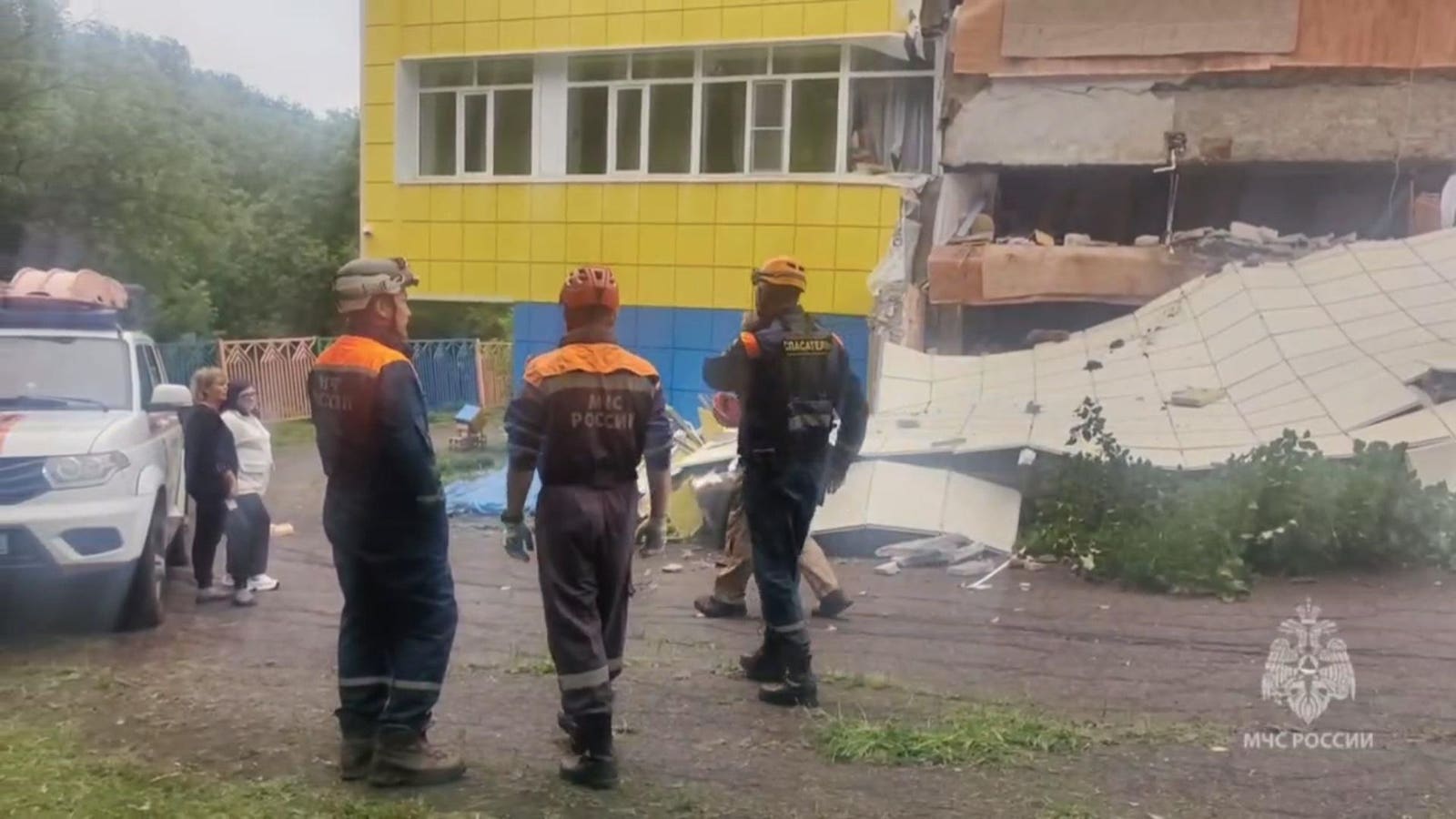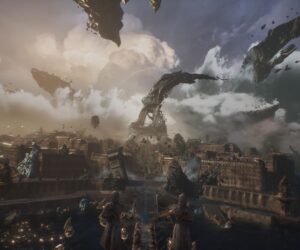This week’s massive magnitude 8.8 earthquake in eastern Russia, which triggered tsunami warnings around the Pacific Ocean, wasn’t the area’s first big earthquake, and it won’t be the last.
KAMCHATKA, RUSSIA – JULY 30: (——EDITORIAL USE ONLY MANDATORY CREDIT – ‘OFFICIAL TELEGRAM CHANNEL OF THE CHIEF DIRECTORATE OF THE MINISTRY OF EMERGENCY SITUATIONS OF RUSSIA FOR KAMCHATKA TERRITORY / HANDOUT’ – NO MARKETING NO ADVERTISING CAMPAIGNS – DISTRIBUTED AS A SERVICE TO CLIENTS——) A screen grab from a video shows rescuers of the Ministry of Emergency Situations of Russia inspecting a damaged building after magnitude 8.8 earthquake hits Kamchatka Peninsula on July 30, 2025 in, Russia. (Photo by Emergency Situations of Russia / Handout/Anadolu via Getty Images)
Anadolu via Getty Images
On August 29, a magnitude 8.8 earthquake rocked the Kamchatka Peninsula, a stretch of land that extends southward into the Bering Sea from Russia’s northeast coast. The earthquake set off an eruption of the northern hemisphere’s tallest volcano, and the shaking seafloor sent tsunamis crashing into the coast of Hawai’i and Japan. Seismographs as far away as northwestern Arkansas in the U.S. recorded the seismic waves from the earthquake. This remote region of Russia is known for producing powerful quakes and destructive tsunamis – so here’s a look at its very shaky seismic past.
Welcome to Kamchatka; mind the earthquakes
The Kamchatka Peninsula juts southward into the Bering Sea from the northeast corner of Russia. Along Kamchatka’s southeast coast runs a chain of islands called Kuril. And between the two, deep beneath the ocean, lies the 6-mile-deep Kuril-Kamchatka Trench. At the bottom of that trench, powerful forces clash slowly – and sometimes release huge bursts of violent energy that shakes the ground and send tremendous waves racing across the ocean.
Here, the single largest piece of Earth’s crust, called the Pacific Plate, is sinking beneath the Okhotsk Plate: a smaller, vaguely triangular shard of continental crust wedged between the Pacific, Eurasian, and North American Plates. This type of fault, called a convergent or thrust fault, can churn up the most powerful earthquakes on the planet, known as megathrust earthquakes. Every magnitude 9.0 or larger earthquake recorded since 1900 (there have been five so far) has happened along a thrust fault like the one east of Kamchatka.
ANKARA, TURKIYE – JULY 30: An infographic titled “Magnitude 8.8 earthquake strikes off Russia’s Kamchatka Peninsula” created in Ankara, Turkiye on July 30, 2025. (Photo by Mehmet Yaren Bozgun/Anadolu via Getty Images)
Anadolu via Getty Images
This is why: the plates move slowly (as befits continent-sized slabs of rock floating atop slowly churning magma), at just about 3 inches a year. But that movement doesn’t happen smoothly and steadily. As the Pacific Plate moves under the Okhotsk Plate, friction between the two plates grinds everything to a halt – but the pressure keeps building, and when it finally breaks loose, it releases all that pent-up energy in the form of a monster megathrust earthquake.
An icy patch in the Ring of Fire
The Pacific and Okhotsk Plates have been slowly colliding since shortly before the extinction of the dinosaurs at the end of the Cretaceous Period 66 million years ago. The fault at the bottom of the Kuril-Kamchatka Trench formed the Kuril Islands, and it spawned Kamchatka’s chain of volcanoes – about 160 of them, 29 of which are active today. In fact, Kamchatka boasts the highest density of volcanoes – and the things that go along with them, like geysers – on the planet. Those include the largest active volcano in the northern hemisphere, Klyuchevskaya Sopka, which rears its snow-capped head 15,500 feet above sea level (and which is now erupting in the wake of the July 29 earthquake).
KAMCHATKA, RUSSIA – AUGUST 19: A general view of Vilyuchinskaya sopka volcano on August 19, 2007 in Kamchatka, Russia. Kamchatka has the highest density of volcanos and associated volcanic phenomena in the world. (Photo by Oleg Nikishin/Epsilon/Getty Images)
Getty Images
So it’s no surprise that of the 20 most powerful earthquakes on record, four have happened along this particular fault.
Before the advent of modern seismic instruments around 1900, we know that at least two major earthquakes happened along the fault east of Kamchatka: one in 1737 and one in 1841. Based on historical descriptions of the earthquakes, the damage, and the tsunamis that followed, both of these quakes probably clocked in at around magnitude 9.0, comparable to the 1952 quake.
Since then, seismic instruments have measured several other extremely powerful earthquakes in the area along this fault: two struck just two months apart in early 1923, with magnitudes 8.2 and 8.4. The worst earthquake in the area so far happened in 1952 and registered at magnitude 9.0. Since then, the fault has also spawned a magnitude 8.4 earthquake in 1958, a magnitude 8.5 in 1963, and magnitude 8. 3 in 1994 followed by two more of the same magnitude in 2006 and 2013.
In other words, major earthquakes happen fairly often (in geological terms) along the coast of Kamchatka and the Kuril Islands. And this fault zone is just one section of the Ring of Fire, a network of faults that, roughly, mark the edges of the Pacific Plate.
Hot spot, There are particular areas in the world where pockets of magma from EarthÍs mantle rise very slowly to the surface. These places are called ñhot spots.î As magma pierces EarthÍs crust, it collects and gradually begins to form small volcanic mountains in the middle of the tectonic plate. The positions of these volcanoes show the movement of the tectonic plates, which are floating on the mantle. As the plates slide, the rising magma creates a new volcano that slowly burns out. In the ocean, hot spots can be identified by the chains of volcanic islands they usually form. The islands of the Hawaiian Archipelago in the middle of the Pacific Ocean were created in this way. (Photo by: QAI Publishing/Universal Images Group via Getty Images)
Universal Images Group via Getty Images
The Ring of Fire runs from New Guinea northwest through Indonesia and the Philippines, then north across Japan and Kamchatka, where it turns east along the Aleutian Islands, then heads south down the Pacific coasts of the Americas to Chile. It’s home to Mount St. Helens and the San Andreas fault in the U.S., and it’s spawned all of the 20 most powerful earthquakes ever recorded.
In case you’re wondering, the July 29 Kamchatka earthquake ranks at number 8 on that list.
It could have been much worse
KAMCHATKA, RUSSIA – JULY 30: (——EDITORIAL USE ONLY – MANDATORY CREDIT – ‘KAMCHATKA OF GEOPHYSICAL SURVEY OF RUSSIAN ACADEMY OF SCIENCES (KBGSRAS) / HANDOUT’ – NO MARKETING NO ADVERTISING CAMPAIGNS – DISTRIBUTED AS A SERVICE TO CLIENTS——) An aerial view of the city of Severo-Kurilsk flooded due to tsunami triggered by the 8.8 magnitude earthquake struck off Russia’s Kamchatka Peninsula on July 30, 2025. The epicenter was located at a depth of 20.7 kilometers (12.8 miles) and was centered 119 kilometers (73.9 miles) east-southeast of Petropavlovsk-Kamchatsky, it said.The earthquake was shallow and powerful enough to trigger waves or a tsunami. (Photo by Kamchatka of Geophysical Survey/Anadolu via Getty Images)
Anadolu via Getty Images
The worst earthquake in Kamchatka’s recent past – and the fifth most powerful earthquake ever recorded anywhere – struck in early November 1952. That earthquake churned up a massive tsunami, which slammed into the Kuril Islands in a series of three waves. Reportedly, the second wave in that series drowned nearly half of the 6,000 residents of Severo-Kurilsk; they had ventured back into the coastal town after the first wave past, thinking the disaster was over and the coast was (ahem) clear, and the second wave caught them off-guard.
(Pro tip: tsunamis often come in multiple waves. Wait them out. Don’t go back to the coast until you hear an all-clear.)
Most of the people living in Severo-Kurilsk in late 1952 were Russian settlers, who had moved to the islands after the Soviet Union invaded and seized the islands from Japan in 1945. In the process, Soviet forces had deported the Japanese civilians who lived on the islands and moved in a bunch of its own citizens. After the earthquake and tsunami, the Soviet government evacuated most of the bedragged survivors back to the Russian mainland.
Eventually, the Soviet Union rebuilt the town further inland, where it still stands today. A tsunami crashed ashore in Severo-Kurilsk after the July 29 quake, but local authorities report no fatalities.









